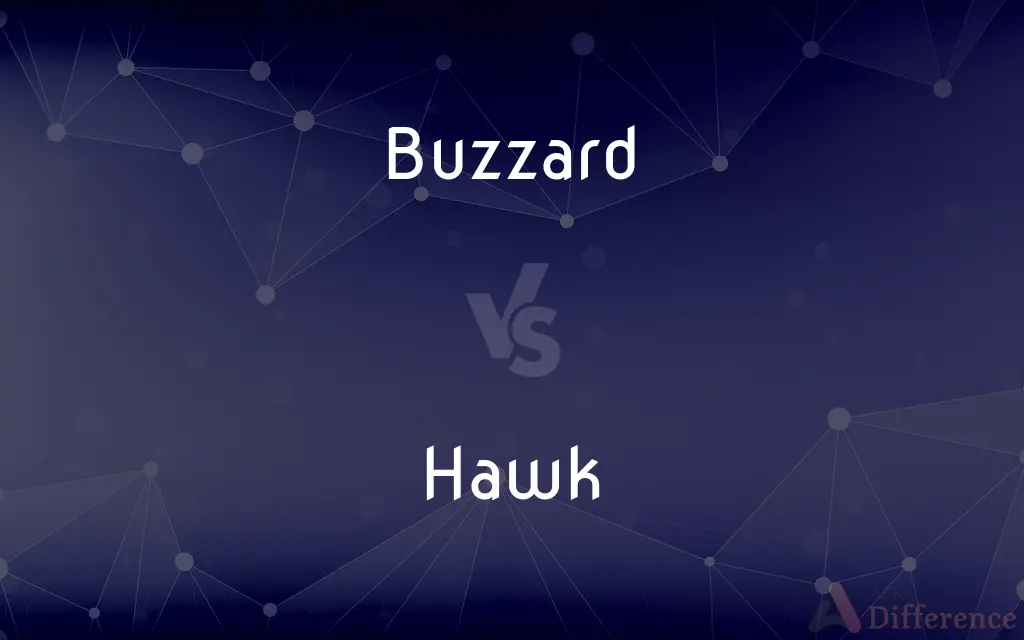Buzzard vs. Hawk — What's the Difference?
By Maham Liaqat & Fiza Rafique — Updated on March 7, 2024
Buzzards are typically larger, broader-winged birds known for their soaring flight, whereas hawks are generally smaller, more agile birds of prey with diverse hunting techniques.

Difference Between Buzzard and Hawk
Table of Contents
ADVERTISEMENT
Key Differences
Buzzards, part of the Buteo genus, are known for their robust build and broad wings, which facilitate their soaring and gliding flight patterns, often seen circling in the sky. This contrasts with hawks, which encompass a wider range of species in different genera, including the Accipiter genus, known for their agility and ability to navigate through dense vegetation during flight, making them adept at ambushing prey.
The term "buzzard" in North America often refers to vultures, particularly turkey vultures, which are scavengers, unlike the true buzzards found in Europe and Asia that actively hunt live prey. Hawks, on the other hand, are found worldwide and include species like the sharp-shinned hawk and the Cooper's hawk, both of which are known for their hunting prowess, targeting birds and small mammals.
Diet and hunting strategies differ between buzzards and hawks. Buzzards tend to rely on their keen vision to spot prey from high altitudes before swooping down, while hawks use a variety of tactics, including swift, surprise attacks from cover or high-speed pursuits to catch their prey.
Despite their differences, both buzzards and hawks play crucial roles in their ecosystems as apex predators, helping to control populations of rodents, smaller birds, and other prey animals, thus maintaining a balanced environment.
Comparison Chart
Size
Generally larger with broader wings.
Usually smaller, more diverse in size.
ADVERTISEMENT
Flight Pattern
Known for soaring and gliding.
Agile, capable of quick turns and fast pursuits.
Geographic Range
More common in Europe and Asia.
Found worldwide, including a wide range in the Americas.
Hunting Style
Soar above and dive to catch prey.
Employ a variety of hunting techniques.
Typical Prey
Small mammals, birds, carrion.
Small mammals, birds, insects.
Compare with Definitions
Buzzard
A bird of prey with broad, rounded wings and a robust body, typically seen soaring in the sky.
The buzzard circled above the open field, scanning for its next meal.
Hawk
A diverse group of birds of prey known for their agility and keen hunting skills.
The hawk swooped down with incredible speed to snatch its prey from the ground.
Buzzard
Found mainly in Europe and Asia, buzzards prefer open landscapes for hunting.
The European buzzard is a common sight in the countryside, especially near wooded areas.
Hawk
Hawks utilize surprise attacks and rapid pursuits to catch their prey.
The sharp-shinned hawk darted through the trees, agilely pursuing a small bird.
Buzzard
In North America, "buzzard" often refers to vultures, not true buzzards.
Many people in the U.S. call turkey vultures buzzards, though they are quite different from the buzzards of Europe and Asia.
Hawk
Found in a wide range of habitats, from dense forests to open countryside.
Hawks adapt to various environments, from the remote wilderness to urban parks.
Buzzard
Primarily feeds on small mammals, insects, and carrion, depending on availability.
After a storm, the buzzard was seen feasting on the carrion left in the fields.
Hawk
Hawks are revered in many cultures for their keen vision and hunting prowess.
In folklore, the hawk is often a symbol of vision and strength.
Buzzard
Often mistaken for eagles due to their size and flight style, but generally smaller.
From a distance, the buzzard's broad wings and soaring flight resemble that of an eagle.
Hawk
Diet consists of small mammals, birds, and insects, varying by species and habitat.
The red-tailed hawk perched high above, eyeing a rodent in the field below.
Buzzard
Buzzard is the common name of several species of bird.
Hawk
Hawks are a group of medium-sized diurnal birds of prey of the family Accipitridae. Hawks are widely distributed and vary greatly in size.
Buzzard
Any of various North American vultures, such as the turkey vulture.
Hawk
Any of various birds of prey, especially of the genera Accipiter and Buteo in the family Accipitridae, characteristically having a short hooked bill and strong claws used for seizing.
Buzzard
Chiefly British A hawk of the genus Buteo, having broad wings and a broad tail.
Hawk
Any of various similar birds of prey.
Buzzard
An avaricious or otherwise unpleasant person.
Hawk
A person who preys on others; a shark.
Buzzard
Any of several Old World birds of prey of the genus Buteo with broad wings and a broad tail.
Hawk
One who demonstrates an actively aggressive or combative attitude, as in an argument.
Buzzard
(North America) Any scavenging bird, such as the American black vulture (Coragyps atratus) or the turkey vulture (Cathartes aura).
Hawk
A person who favors military force or action in order to carry out foreign policy.
Buzzard
In North America, a curmudgeonly or cantankerous man; an old person; a mean, greedy person.
Hawk
An audible effort to clear the throat by expelling phlegm.
Buzzard
(archaic) A blockhead; a dunce.
Hawk
To hunt with trained hawks.
Buzzard
(golf) double bogey
Hawk
To swoop and strike in the manner of a hawk
"It was fun to watch the scattered snail kites ... lifting and falling in the wind as they hawked across the shining grass and water" (Peter Matthiessen).
Buzzard
A bird of prey of the Hawk family, belonging to the genus Buteo and related genera.
Hawk
To peddle goods aggressively, especially by calling out.
Buzzard
In the United States, a term used for the turkey vulture (Cathartes aura), and sometimes indiscriminately to any vulture.
Hawk
To peddle (goods) aggressively, especially by calling out.
Buzzard
A blockhead; a dunce.
It is common, to a proverb, to call one who can not be taught, or who continues obstinately ignorant, a buzzard.
Hawk
To clear or attempt to clear the throat by or as if by coughing up phlegm.
Buzzard
Senseless; stupid.
Hawk
To clear the throat of (phlegm).
Buzzard
Common in South America and Central America and southern United States
Hawk
A diurnal predatory bird of the family Accipitridae, smaller than an eagle.
It is illegal to hunt hawks or other raptors in many parts of the world.
Buzzard
The common European short-winged hawk
Hawk
Any diurnal predatory terrestrial bird of similar size and appearance to the accipitrid hawks, such as a falcon.
Hawk
(entomology) Any of various species of dragonfly of the genera Apocordulia and Austrocordulia, endemic to Australia.
Hawk
(politics) An advocate of aggressive political positions and actions.
Hawk
(game theory) An uncooperative or purely-selfish participant in an exchange or game, especially when untrusting, acquisitive or treacherous. Refers specifically to the Prisoner's Dilemma, alias the Hawk-Dove game.
Hawk
A plasterer's tool, made of a flat surface with a handle below, used to hold an amount of plaster prior to application to the wall or ceiling being worked on: a mortarboard.
Hawk
A noisy effort to force up phlegm from the throat.
Hawk
(transitive) To hunt with a hawk.
Hawk
(intransitive) To make an attack while on the wing; to soar and strike like a hawk.
To hawk at flies
Hawk
(transitive) To sell; to offer for sale by outcry in the street; to carry (merchandise) about from place to place for sale; to peddle.
The vendors were hawking their wares from little tables lining either side of the market square.
Hawk
To expectorate, to cough up something from one's throat.
Hawk
To try to cough up something from one's throat; to clear the throat loudly.
Grandpa sat on the front porch, hawking and wheezing, as he packed his pipe with cheap tobacco.
Hawk
One of numerous species and genera of rapacious birds of the family Falconidæ. They differ from the true falcons in lacking the prominent tooth and notch of the bill, and in having shorter and less pointed wings. Many are of large size and grade into the eagles. Some, as the goshawk, were formerly trained like falcons. In a more general sense the word is not infrequently applied, also, to true falcons, as the sparrow hawk, pigeon hawk, duck hawk, and prairie hawk.
Hawk
An effort to force up phlegm from the throat, accompanied with noise.
Hawk
A small board, with a handle on the under side, to hold mortar.
Hawk
To catch, or attempt to catch, birds by means of hawks trained for the purpose, and let loose on the prey; to practice falconry.
A falconer Henry is, when Emma hawks.
Hawk
To make an attack while on the wing; to soar and strike like a hawk; - generally with at; as, to hawk at flies.
A falcon, towering in her pride of place,Was by a mousing owl hawked at and killed.
Hawk
To clear the throat with an audible sound by forcing an expiratory current of air through the narrow passage between the depressed soft palate and the root of the tongue, thus aiding in the removal of foreign substances.
Hawk
To raise by hawking, as phlegm.
Hawk
To offer for sale by outcry in the street; to carry (merchandise) about from place to place for sale; to peddle; as, to hawk goods or pamphlets.
His works were hawked in every street.
Hawk
Diurnal bird of prey typically having short rounded wings and a long tail
Hawk
An advocate of an aggressive policy on foreign relations
Hawk
A square board with a handle underneath; used by masons to hold or carry mortar
Hawk
Sell or offer for sale from place to place
Hawk
Hunt with hawks;
The Arabs like to hawk in the desert
Hawk
Clear mucus or food from one's throat;
He cleared his throat before he started to speak
Common Curiosities
Can buzzards and hawks be found in the same habitats?
Yes, their habitats can overlap, especially in regions where open countryside meets wooded areas.
Are all buzzards larger than hawks?
Generally, buzzards are larger, but there is size overlap between smaller buzzards and larger hawks.
Do buzzards hunt live prey or are they scavengers?
True buzzards primarily hunt live prey, though they may scavenge occasionally.
Is the term "buzzard" used correctly in North America?
In North America, "buzzard" commonly refers to vultures, which is a misnomer when compared to the true buzzards of Europe and Asia.
How do hawks adapt to urban environments?
Hawks, like the peregrine falcon, adapt by nesting on tall buildings and hunting abundant city birds and rodents.
Are buzzards and hawks protected species?
Many species of buzzards and hawks are protected under various wildlife conservation laws.
Are buzzards or hawks more likely to be seen in groups?
Hawks are more often solitary, while buzzards might be seen in groups, especially during migration.
How do buzzard and hawk diets compare?
Both primarily eat small animals, but specific preferences can vary by species and available prey.
What role do buzzards and hawks play in ecosystem balance?
They control populations of rodents and other small animals, helping to maintain ecological balance.
What distinguishes a hawk's flight from a buzzard's?
Hawks are more agile with quicker, more varied maneuvers, while buzzards prefer soaring and gliding.
How do weather conditions affect buzzard and hawk hunting patterns?
Adverse weather can limit flight and hunting efficiency, with both species potentially becoming more reliant on scavenged food.
What impact do human activities have on buzzard and hawk populations?
Habitat destruction, pollution, and persecution can threaten their populations, though many species have adapted to urban environments.
Can buzzards and hawks be kept as pets or for falconry?
While some hawks are used in falconry, both buzzards and hawks generally require special licenses to be kept legally.
Do buzzards and hawks have any natural predators?
As apex predators, adult buzzards and hawks have few natural predators, though eggs and young can be vulnerable.
How can one differentiate between a buzzard and a hawk in flight?
Look for differences in wing shape, flight style, and soaring patterns, with buzzards showing broader wings and more circling.
Share Your Discovery

Previous Comparison
Antibiotic vs. Antimicrobial
Next Comparison
Joy vs. EnjoyAuthor Spotlight
Written by
Maham LiaqatCo-written by
Fiza RafiqueFiza Rafique is a skilled content writer at AskDifference.com, where she meticulously refines and enhances written pieces. Drawing from her vast editorial expertise, Fiza ensures clarity, accuracy, and precision in every article. Passionate about language, she continually seeks to elevate the quality of content for readers worldwide.
















































